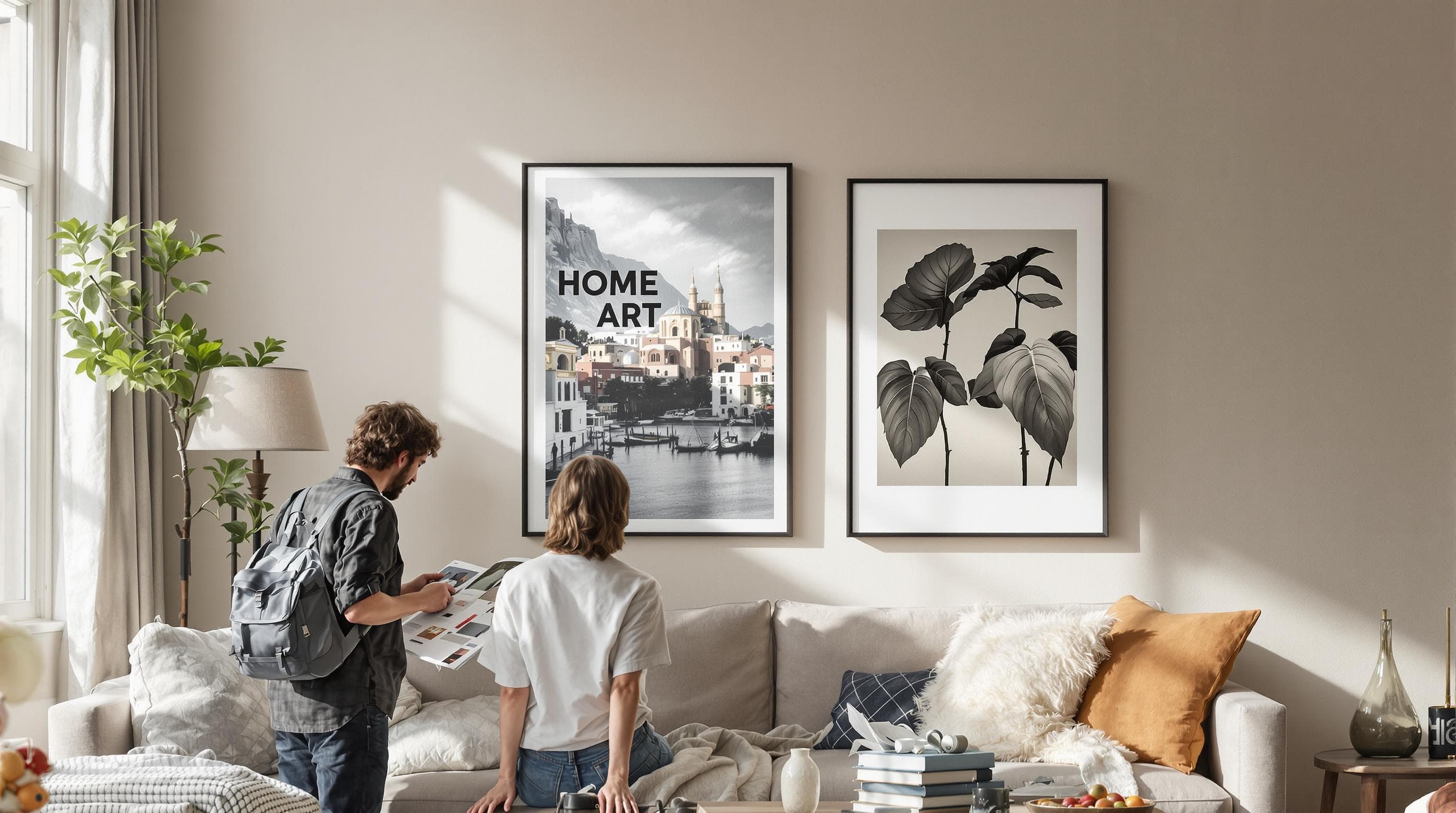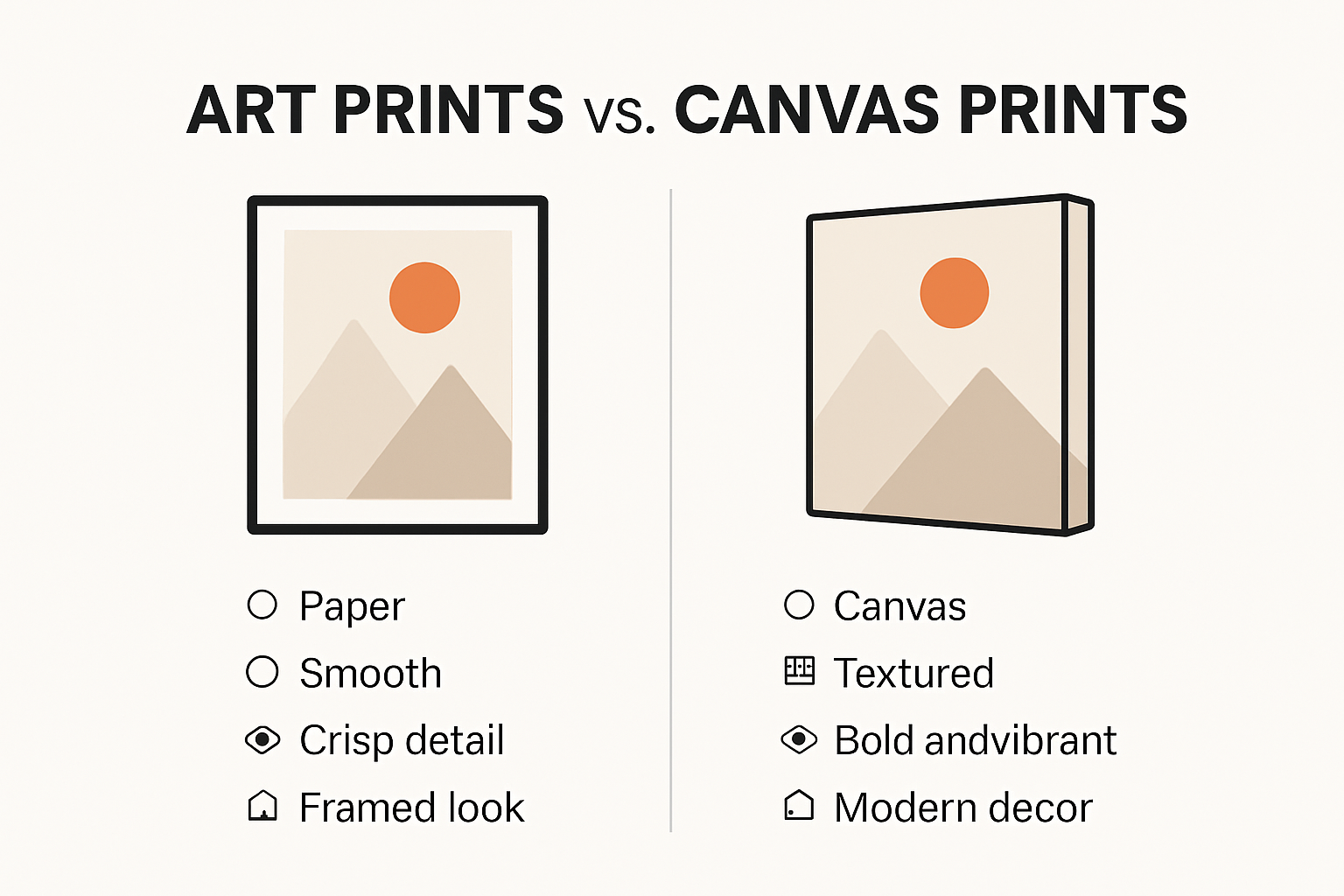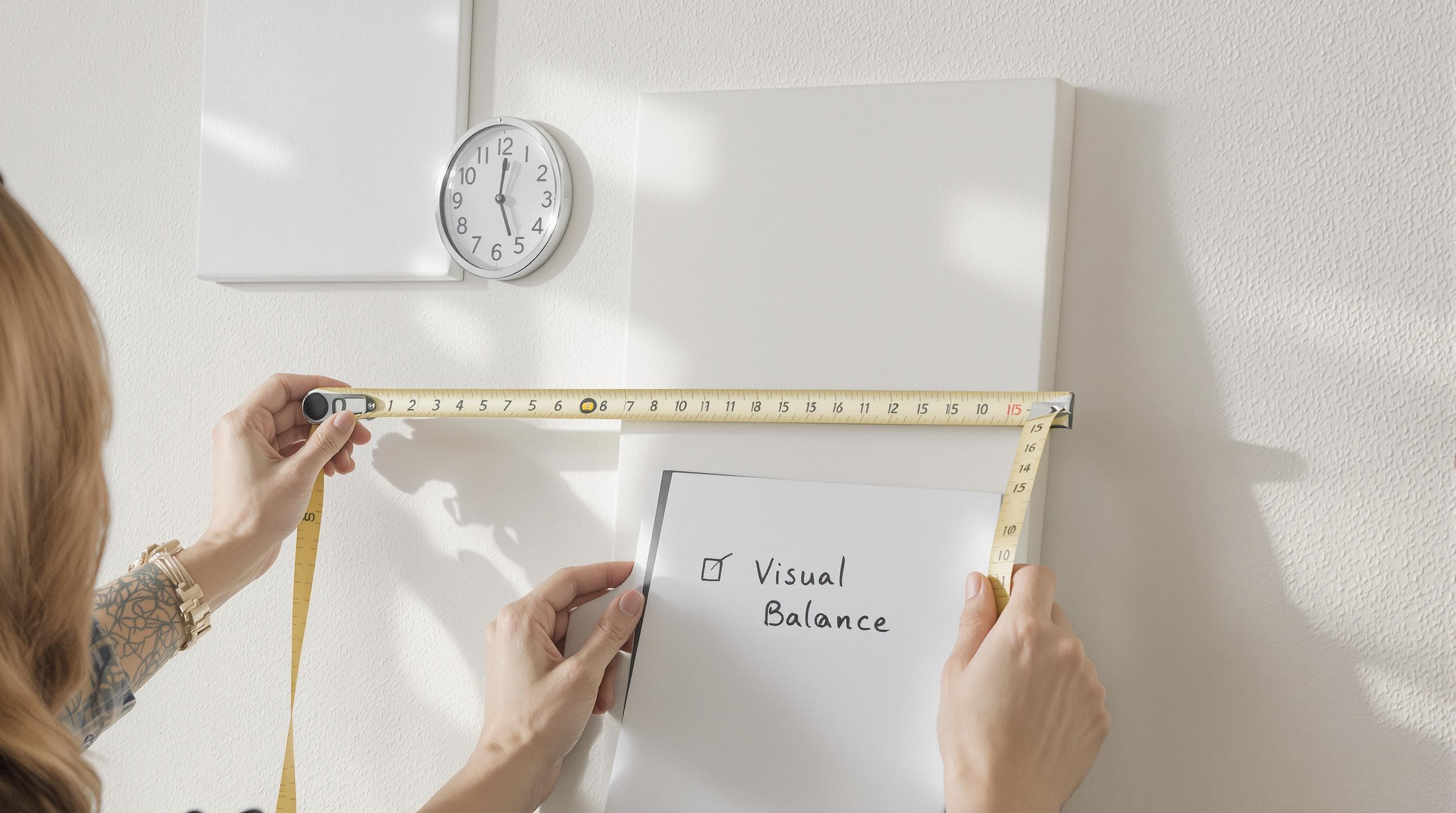
Art Print vs Canvas: Best Choice for Modern Home Decor 2025

Modern home decor is changing fast with more people turning to art prints and canvas prints to make their spaces stand out. Some experts even report that canvas wall art sales have jumped by over 27 percent in the last year alone. Most people assume that canvas prints are only about texture or trend, while art prints are all about detail and tradition. In reality, your choice could influence not just the look of your room but even your mood and well-being in ways you might not expect.
Table of Contents
- Understanding Art Print vs Canvas Basics
- Pros And Cons For Collectors And Decorators
- Style, Placement, And Care Tips
- How To Choose The Perfect Wall Art
Quick Summary
| Takeaway | Explanation |
|---|---|
| Art Print vs Canvas Print | Art prints are reproductions on high-quality paper, while canvas prints use durable canvas material for a textured, organic look. |
| Durability Matters | Canvas prints are more resistant to environmental factors and maintain color integrity, making them a long-lasting choice. Conversely, art prints offer superior detail but require more careful handling. |
| Strategic Art Placement | For optimal visual impact, hang artwork at eye level (57-60 inches) and consider how it complements existing decor to create harmonious designs. |
| Emotional Influence | Choose art that resonates with you emotionally and mirrors your personal narrative, as this can significantly enhance your psychological well-being. |
| Practical Considerations | Assess factors like budget, maintenance, and longevity when choosing wall art; canvas prints are often more durable and cost-effective for larger pieces. |
Understanding Art Print vs Canvas Basics
Art decor is an essential element of modern home design, with canvas prints and art prints emerging as two popular options for transforming living spaces. Understanding the fundamental differences between these artistic mediums can help you make an informed decision for your home.
What Defines Art Prints and Canvas Prints
An art print is a reproduction of an original artwork created using various printing techniques. According to Encyclopedia Britannica, these can include methods like lithography, screen printing, and digital printing on paper or other materials. Canvas prints, by contrast, involve printing images directly onto canvas material.
Canvas is a durable, plain-woven fabric traditionally made from hemp, now commonly produced from cotton or linen. When used for art reproduction, the canvas provides a unique texture that adds depth and dimension to the artwork. The printing process transforms a digital or photographic image into a textured, gallery-ready piece that mimics the appearance of an original painting.
Key Characteristics and Visual Differences
The primary distinction between art prints and canvas prints lies in their physical properties and visual appeal. Art prints typically feature crisp, clean lines and are often printed on high-quality paper, making them ideal for detailed images and precise graphic designs. Canvas prints, however, offer a more organic, painterly appearance with a slightly textured surface that can soften photographic images and add artistic depth.
When considering home decor, canvas prints provide a more contemporary and dimensional look. Research from Art Market Research suggests that canvas prints have gained significant popularity in modern interior design due to their ability to create a gallery-like aesthetic without the need for additional framing.
For art enthusiasts looking to explore more about different print techniques, check out our comprehensive guide on art print varieties. This resource offers deeper insights into the world of artistic reproductions and can help you make an informed choice for your home decor.

Choosing between art prints and canvas prints ultimately depends on your personal style, the specific artwork, and the ambiance you want to create in your living space. Both mediums offer unique ways to express creativity and personalize your home environment, transforming blank walls into compelling visual narratives that reflect your individual taste and aesthetic sensibilities.
To help you compare the essential features of art prints and canvas prints at a glance, here’s a table outlining their key characteristics, strengths, and considerations:
| Feature | Art Prints | Canvas Prints |
|---|---|---|
| Material | High-quality paper | Woven canvas (cotton/linen) |
| Texture | Smooth, crisp surface | Textured, painterly surface |
| Detail | High, sharp details | Slightly softened, painterly effect |
| Durability | Needs careful handling, sensitive to environment | Durable, UV/moisture resistant |
| Presentation | Usually framed, sometimes matted | Often unframed, gallery wrapped |
| Best For | Graphic designs, fine details | Photographs, paintings, contemporary looks |
| Cost (Large Sizes) | Higher for framing/mounting | Generally more affordable |
| Collector Value | High with limited/signed editions | Typically decorative |
Pros and Cons for Collectors and Decorators
Art collectors and home decorators face nuanced choices when selecting between art prints and canvas prints. Each medium brings unique advantages and potential limitations that can significantly impact the aesthetic and longevity of artwork in a living space.
Durability and Longevity Considerations
Canvas prints offer remarkable durability that sets them apart in the art reproduction world. According to 365 Canvas Research, these prints are exceptionally resistant to environmental factors like moisture and direct sunlight. UV-resistant inks ensure that canvas prints maintain their vibrant colors and integrity over extended periods.
Art prints, while delicate, provide precision and detail that canvas cannot always replicate. Print Collector Magazine notes that high-quality art prints on archival paper can preserve intricate graphic elements and sharp lines with exceptional clarity. However, they require more careful handling and protection from environmental conditions.
Visual Aesthetics and Presentation
The textural qualities of canvas prints create a unique visual experience. As Art Reproduction Quarterly explains, the woven surface adds depth and dimensionality that transforms a simple image into a more painterly representation. This characteristic makes canvas prints particularly appealing for reproductions of original paintings or photographic art that benefit from a soft, organic appearance.
Art prints, conversely, excel in presenting graphic designs, architectural renderings, and images requiring precise detail. Their smooth surface allows for crisp reproduction of complex visual elements that might appear slightly muted on canvas.
Cost and Collector Value
Budget considerations play a significant role in art selection. Canvas prints generally offer a more affordable option for acquiring large-scale artwork. Home Decor Insights suggests that canvas prints provide an economical way to display high-quality art reproductions without the substantial investment of original pieces.
For serious art collectors, limited edition art prints often retain better potential for appreciation. Numbered and signed prints can become valuable collectibles, whereas canvas prints are typically seen as decorative items.
The choice between art prints and canvas prints ultimately depends on individual preferences, intended display environment, and specific aesthetic goals. Whether you prioritize durability, visual texture, or collectible value, understanding these nuanced differences empowers collectors and decorators to make informed decisions that enhance their living spaces.
Style, Placement, and Care Tips
Transforming your living space with art prints and canvas prints requires more than just selecting beautiful artwork. Strategic placement, thoughtful styling, and proper maintenance are crucial to creating a visually stunning and long-lasting display.
Strategic Placement and Design Harmony
Placing artwork effectively can dramatically enhance the visual appeal of any room. According to Coohom Design Experts, the optimal height for hanging artwork is between 57 and 60 inches from the floor to the center of the piece. This approach ensures the artwork is at eye level and creates a balanced visual experience.
Consider the surrounding decor when selecting and positioning your art. Canvas prints work exceptionally well as focal points in living rooms, bedrooms, and home offices. SHE DEFINED Interior Design suggests using canvas art to tie together design elements, creating a cohesive look that reflects your personal style.

Maintenance and Preservation Techniques
Preserving the quality of your art prints and canvas prints requires careful attention. Art prints demand more delicate handling due to their paper composition. Store them in acid-free folders or portfolios when not displayed, and avoid hanging them in direct sunlight or areas with high humidity.
Canvas prints offer more durability but still benefit from proper care. Preserving Canvas Artwork recommends occasional gentle dusting with a soft, dry microfiber cloth. Avoid using water or cleaning solutions directly on the canvas, as these can damage the print’s surface and color integrity.
The following table summarizes the recommended maintenance and preservation tips for both art prints and canvas prints, helping ensure your wall art remains vibrant and beautiful:
| Care Aspect | Art Prints | Canvas Prints |
|---|---|---|
| Handling | Handle with clean, dry hands; avoid touching surface | Handle by frame/edges; less sensitive |
| Cleaning | Dust gently with soft brush or cloth | Dust with dry microfiber cloth only |
| Storage | Store in acid-free folders/portfolios | Store upright/in cool, dry place |
| Display Precautions | Avoid direct sunlight/humidity | Resist some sunlight; still avoid moisture |
| Cleaning Agents | Never use liquids | Never use water/cleaners |
Styling Tips for Modern Home Decor
Creating a visually compelling display involves more than just hanging artwork. Mix different sizes and orientations to create visual interest. Consider creating a gallery wall with a combination of art prints and canvas prints, using complementary frames or allowing canvas prints to remain unframed for a modern, minimalist look.
Color coordination plays a crucial role in art placement. Select pieces that either complement or intentionally contrast with your existing color scheme. For neutral rooms, a vibrant canvas print can serve as a striking accent piece. Conversely, in more colorful spaces, a monochromatic or subtle art print can provide visual balance.
Remember that art is a personal expression. The most important aspect of selecting and displaying art prints or canvas prints is choosing pieces that resonate with you and enhance your living environment. Whether you prefer bold, contemporary designs or more subtle, classic artwork, the right placement and care can transform your space into a personalized gallery that tells your unique story.
How to Choose the Perfect Wall Art
Selecting the ideal wall art requires more than aesthetic appreciation. It involves understanding how visual elements interact with your living space, personal style, and emotional well-being. Making an informed choice can transform a room from ordinary to extraordinary.
Understanding Personal Style and Room Dynamics
Choosing wall art is a deeply personal journey that reflects individual taste and environmental context. According to the Smithsonian Magazine, successful art selection hinges on understanding the interplay between personal preference, room characteristics, and artistic expression.
Consider the existing color palette, furniture style, and architectural elements of your space. Art should complement rather than compete with your room’s design. For instance, minimalist rooms might benefit from bold, graphic art prints, while more ornate spaces could showcase softer, textured canvas pieces.
Psychological Impact and Emotional Resonance
Research from the National Institutes of Health reveals that wall art significantly influences psychological well-being. The artwork you choose can evoke emotions, create atmosphere, and reflect your personal narrative. Select pieces that resonate with you on an emotional level, not just visual appeal.
Size and proportion play crucial roles in art’s psychological impact. A piece too small can feel lost, while an oversized artwork might overwhelm the space. Aim for art that occupies approximately two-thirds to three-quarters of the wall space above furniture, creating visual balance and harmony.
Practical Considerations for Art Selection
Beyond aesthetic considerations, practical factors determine the perfect wall art. Budget, maintenance requirements, and longevity are essential considerations. Canvas prints offer durability and a painterly texture, while art prints provide crisp details and versatility.
Learn more about curating your living room art collection to understand how to create a cohesive and meaningful display. Consider creating visual interest through varied sizes, complementary themes, or a gallery wall arrangement that tells a personal story.
Remember that art is not just decoration but a form of self-expression. Trust your instincts, choose pieces that spark joy, and don’t be afraid to mix art print and canvas styles. The most compelling spaces reflect the unique personality and experiences of their inhabitants, transforming walls from mere boundaries into canvases of personal narrative and artistic exploration.
Frequently Asked Questions
What is the difference between art prints and canvas prints?
Art prints are reproductions on high-quality paper, featuring crisp details, while canvas prints are printed on canvas material, providing a textured, painterly appearance.
Which is more durable: art prints or canvas prints?
Canvas prints are generally more durable and resistant to environmental factors such as moisture and sunlight, whereas art prints require careful handling and protection to maintain their quality over time.
How should I display art prints and canvas prints?
For optimal viewing, hang artwork at eye level (between 57 and 60 inches from the floor). Consider how the piece complements the surrounding decor to create a cohesive and harmonious design.
What are some factors to consider when choosing wall art?
Consider personal style, room dynamics, and the emotional resonance of the artwork. Additionally, assess budget, maintenance needs, and the longevity of the medium when making your selection.
Bring Gallery-Level Art Into Your Home With Marta Ellie
Making the right choice between art prints and canvas prints can feel overwhelming, especially when you want decor that not only looks stunning but also stands the test of time. If you feel stuck deciding between sharp detail and rich texture or you are seeking a way to add true modern elegance to your space, our handpicked collections at Marta Ellie can help you transform your walls with ease. Discover themed series like our Art Gallery Opening Night Wall Art for canvas pieces that give your home a sophisticated, gallery-inspired feel.

Do not miss the chance to refresh your space with original, high-quality wall art made for lasting beauty. Shop our full collections or explore our artist’s story at Marta Ellie to find that perfect print or canvas piece your room has been missing. Now is the time to invest in the style and atmosphere that truly reflect who you are and where you want to be.
Recommended
- Living Room Wall Art Trends 2025: Modern Canvas and Print Ideas – Exclusive Canvas Art
- What Is Canvas Print? Modern Wall Art for Stylish Spaces 2025 – Exclusive Canvas Art
- Canvas Art Meaning: Modern Decor & Artistic Value in 2025 – Exclusive Canvas Art
- How to Display Canvas Prints: Fresh Ideas for Modern Walls 2025 – Exclusive Canvas Art